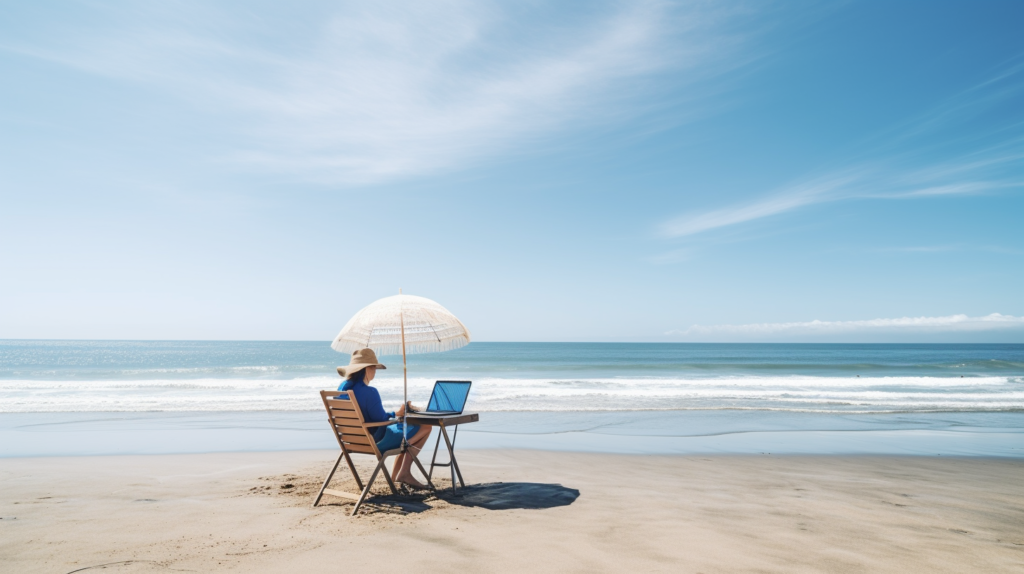1. Introduction
Working remotely while traveling is becoming increasingly popular as technology enables people to work from anywhere in the world.
This lifestyle allows for the freedom to explore new places, cultures, and experiences while maintaining a source of income.
However, it also requires careful planning, discipline, and flexibility.
Remote workers who travel face unique challenges such as limited access to reliable internet and other resources, difficulty in maintaining work-life boundaries, and cultural differences that may affect work relationships and productivity.
Despite these challenges, the benefits of working remotely while traveling are many.
It can lead to increased creativity and inspiration from new experiences, reduced stress and burnout, improved work-life balance and well-being, the opportunity to build a global network and diverse skill set, and increased financial savings from lower living costs in some destinations.
This ultimate guide provides remote workers and digital nomads with all the tips and tricks they need to make the most out of their travels while maintaining their work productivity.
We will cover everything from planning your work and travel schedule to finding suitable accommodation, setting up your mobile office, staying connected to the internet, managing your time and productivity, staying healthy and fit, networking and building connections, taking advantage of your travel experiences, dealing with the unexpected, and staying safe and secure.
By following the advice in this guide, you can make the most out of your remote work and travel lifestyle and achieve your personal and professional goals.

2. The Benefits of Working Remotely
Working remotely while traveling has numerous benefits that make it an attractive lifestyle choice for many people.
Here are some of the key advantages:
More freedom and flexibility: One of the biggest advantages of working remotely while traveling is the freedom to work from anywhere in the world.
This allows you to explore new places, cultures, and experiences that you might not have been able to otherwise.
You can choose to work from a beach in Bali, a café in Paris, or a mountain retreat in Colorado.
Additionally, working remotely allows for flexibility in your work schedule, so you can take advantage of opportunities to travel and explore without compromising your job responsibilities.Increased creativity and inspiration:Traveling can be a great source of inspiration and creativity, especially for those who work in creative fields such as writing, photography, or design.
Experiencing new cultures, sights, and sounds can stimulate the mind and lead to fresh ideas and perspectives.Reduced stress and burnout: The combination of work and travel can be a great way to reduce stress and prevent burnout.
Changing your environment and routine can be refreshing and help to avoid feeling stuck in a rut.
Being able to enjoy leisure activities and sights during non-work hours can also help to alleviate stress and prevent burnout.Improved work-life balance and well-being: Remote work allows for greater flexibility in scheduling, which can lead to a better work-life balance.
Being able to work from anywhere in the world allows for greater autonomy and control over one’s own life.
This can lead to better mental health and overall well-being.Opportunity to build a global network and diverse skill set: When working remotely while traveling, you have the opportunity to meet people from all over the world and build a global network.
This can lead to new business opportunities and collaborations.
Additionally, working in different environments and cultures can help you develop new skills and a more diverse perspective.Increased financial savings: Depending on where you travel, working remotely can lead to cost savings on living expenses.
For example, if you are from a high-cost city such as New York or San Francisco, you may be able to save money by traveling to a lower-cost destination such as Southeast Asia or South America.
This can lead to a more affordable and sustainable lifestyle.

3. Challenges of Working Remotely
While working remotely while traveling has many benefits, it also presents a unique set of challenges that must be overcome.
Here are some of the key challenges to consider:
Difficulty in maintaining work-life boundaries and avoiding distractions: When working remotely while traveling, it can be difficult to maintain a healthy work-life balance.
It can be tempting to work all the time, especially if you are in a new and exciting destination.
Additionally, it can be challenging to avoid distractions, such as tourist attractions, social events, or other travel-related activities.Limited access to reliable internet and other resources in some locations: Not all destinations are created equal when it comes to internet access and other resources.
Some remote locations may have limited or no access to reliable internet, which can make it difficult to work effectively.
Additionally, other resources such as printing, scanning, or office supplies may be limited or non-existent in some locations.Time zone differences and communication barriers with clients and colleagues: Working remotely while traveling can also present challenges when it comes to communicating with clients and colleagues.
Time zone differences can make it difficult to schedule meetings or collaborate in real-time.
Additionally, language barriers and cultural differences can lead to misunderstandings or miscommunication.Health and safety risks in some destinations: Traveling to new and unfamiliar destinations can present health and safety risks.
Illness, crime, or natural disasters can all pose risks to remote workers.
It is important to research the safety and security measures of your destination and take appropriate precautions.Cultural differences and language barriers that may affect work relationships and productivity: Working remotely while traveling can also present challenges when it comes to working with clients and colleagues from different cultures.
Language barriers and cultural differences can lead to misunderstandings or miscommunication.
Additionally, different work styles and expectations may affect productivity and work relationships.Legal and tax issues related to remote work and international travel: Working remotely while traveling can present legal and tax challenges, especially when working across international borders.
Different countries have different laws and regulations when it comes to remote work and income earned abroad.
It is important to research and understand the legal and tax implications of your remote work and travel lifestyle.

4. Planning Your Work and Travel Schedule
Effective planning is key to a successful remote work and travel lifestyle.
Here are some tips for planning your work and travel schedule:
Choose your destinations wisely: When planning your travel schedule, consider the destinations that you will be visiting carefully.
Some destinations may have better internet access, more suitable workspaces, or lower living costs than others.
It is important to do your research and choose destinations that are compatible with your work and travel needs.Set realistic goals and deadlines: When working remotely while traveling, it can be challenging to balance work and leisure time effectively.
Setting realistic goals and deadlines for both work and personal activities can help you stay on track and avoid burnout.
Make a schedule that allows time for work and leisure activities, and stick to it as much as possible.Create a budget: Creating a budget for your remote work and travel lifestyle can help you manage your finances effectively.
Consider factors such as transportation, accommodation, food, and activities, and set a realistic budget for each category.
Be sure to account for any additional costs related to your remote work, such as internet access or software subscriptions.Plan for time zone differences: When working remotely with clients or colleagues in different time zones, it is important to plan for time zone differences.
Consider using tools such as time zone converters or scheduling apps to help you manage communication and meetings across different time zones.Prepare for emergencies: It is important to prepare for emergencies when working remotely while traveling.
Consider purchasing travel insurance or health insurance to cover unexpected expenses.
Additionally, have a backup plan in case of emergencies or unexpected events, such as illness or natural disasters.Communicate with your clients or colleagues: Communication is key when working remotely while traveling.
Be sure to communicate with your clients or colleagues regularly to keep them informed of your schedule and progress.
Use video conferencing tools or messaging apps to stay in touch, and be sure to set clear expectations for communication and availability.

5. Finding Suitable Accommodation
Finding suitable accommodation is crucial for a successful remote work and travel lifestyle.
Here are some tips for finding the right accommodation:
Research your options: There are many different types of accommodation available for remote workers and digital nomads, such as vacation rentals, co-living spaces, or camping sites.
Research the different options available in your destination and consider factors such as cost, location, amenities, and access to reliable internet and workspaces.Read reviews and ratings: Before booking accommodation, be sure to read reviews and ratings from previous guests.
This can help you avoid scams or fraudulent listings, and provide you with a more accurate picture of what to expect from your accommodation.Communicate with hosts or property managers: When booking accommodation, it is important to communicate with hosts or property managers to clarify any questions or concerns you may have.
Be sure to ask about internet access, workspaces, or other amenities that are important to your remote work.Choose a suitable workspace: When working remotely while traveling, having a suitable workspace is essential.
Choose accommodation that provides a comfortable and ergonomic workspace, such as a desk, chair, and good lighting.
Additionally, consider other factors such as noise levels or distractions that may affect your productivity.Consider the cost: Accommodation costs can vary widely depending on your destination and the type of accommodation you choose.
Consider your budget carefully and choose accommodation that is affordable and sustainable for your remote work and travel lifestyle.Plan for long-term stays: If you plan on staying in one location for an extended period of time, consider booking accommodation for a longer-term stay.
This can often lead to lower costs and more stable accommodation options. Additionally, consider other factors such as visas or legal requirements for long-term stays in your destination.Consider a House Sit: Probably one of the more affordable options is to look for house sits.
You can live in most places around the world for free in exchange for looking after a home and pets.
This way you are guaranteed to immerse yourself in the local culture by living like people do, as an added bonus you get to spend time with some incredible animals.
I recommend trusted house sitters as it’s the biggest housesitting network online.
Yes, it’s more expensive than most other programs but if you consider that you could stay somewhere for free sometimes even for months you could save thousands of dollars.

6. Setting up Your Mobile Office
Setting up a mobile office is essential for remote workers who travel.
Here are some tips for setting up your mobile office:
Choose the right equipment: When setting up your mobile office, choose equipment that is lightweight, portable, and reliable.
Consider investing in a laptop or tablet with a long battery life, a wireless mouse and keyboard, and noise-canceling headphones.Use cloud-based software and storage: Cloud-based software and storage can make it easier to work remotely while traveling.
Consider using tools such as Google Drive, Dropbox, or Trello to collaborate with colleagues and store important documents.Use a virtual private network (VPN): A virtual private network (VPN) can provide additional security when working remotely while traveling.
A VPN encrypts your internet connection and protects your online privacy, which can be especially important when using public Wi-Fi.Carry a portable hotspot: A portable hotspot can provide reliable internet access when traveling to destinations with limited or no internet access.
Consider investing in a portable hotspot or using your smartphone as a mobile hotspot.Find suitable workspaces: When traveling to new destinations, it is important to find suitable workspaces where you can be productive.
Consider coworking spaces, libraries, or cafes with reliable internet access and comfortable workspaces.Stay organized: When working remotely while traveling, it can be easy to lose track of important documents or tasks.
Stay organized by using to-do lists, calendars, and other organizational tools.
Consider using project management tools such as Asana or Trello to manage your work and stay on top of deadlines.Minimize distractions: Minimizing distractions is essential when working remotely while traveling.
Consider using productivity tools such as the Pomodoro Technique, which involves working in focused 25-minute intervals with 5-minute breaks in between.
By setting up a mobile office, remote workers can maintain their productivity and work effectively while traveling.

7. Staying Connected to the Internet
Staying connected to the internet is crucial for remote workers who travel.
Here are some tips for staying connected:
Research internet access options: Before traveling to a new destination, research the different options for internet access.
Consider factors such as availability, speed, reliability, and cost.Use public Wi-Fi with caution: When using public Wi-Fi, it is important to take precautions to protect your online privacy and security.
Avoid accessing sensitive information or making online transactions when using public Wi-Fi.
Consider using a virtual private network (VPN) to encrypt your internet connection and protect your online privacy.Carry a portable hotspot: A portable hotspot can provide reliable internet access when traveling to destinations with limited or no internet access.
Consider investing in a portable hotspot or using your smartphone as a mobile hotspot.Use internet cafes or coworking spaces: Internet cafes and coworking spaces can provide reliable internet access and comfortable workspaces for remote workers who travel.
Consider researching the options available in your destination and choose a suitable workspace.Use offline capabilities: Many software applications, such as Google Docs or Microsoft Office, have offline capabilities that allow you to work without an internet connection.
Consider using these offline capabilities when working in locations with limited or no internet access.Communicate with clients or colleagues: When experiencing internet connectivity issues, be sure to communicate with your clients or colleagues to inform them of any delays or issues.
Use messaging apps or email to stay in touch and keep them informed of your progress.
By staying connected to the internet, remote workers can maintain their productivity and stay in touch with clients or colleagues while traveling.

8. Managing Your Time and Productivity
Managing time and productivity is essential for remote workers who travel.
Here are some tips for managing your time and productivity:
Set clear goals and priorities: When working remotely while traveling, it can be easy to get distracted or lose focus.
Set clear goals and priorities for your work and break them down into smaller, achievable tasks.Use time-management techniques: Time-management techniques, such as the Pomodoro Technique or time-blocking, can help you stay focused and productive. Experiment with different techniques to find what works best for you.
Establish a routine: Establishing a routine can help you stay organized and maintain a healthy work-life balance.
Set specific work hours and stick to them as much as possible.
Additionally, establish a routine for your leisure activities to help you balance work and play.Minimize distractions: Minimizing distractions is essential for staying productive while working remotely while traveling.
Use noise-cancelling headphones or find a quiet workspace to help you stay focused. Additionally, consider using productivity tools to block social media or other distractions.Take breaks: Taking regular breaks is important for maintaining productivity and avoiding burnout.
Use your breaks to engage in physical activity or other leisure activities to help you relax and recharge.Manage your energy levels: Managing your energy levels is important when working remotely while traveling.
Plan your work schedule around your natural energy levels and avoid working when you are feeling tired or unfocused.
By managing your time and productivity, remote workers can maintain a healthy work-life balance and achieve their professional goals while traveling.

9. Maintaining a Healthy Lifestyle
Maintaining a healthy lifestyle is essential for remote workers who travel.
Here are some tips for staying healthy while working remotely:
Prioritize physical activity: Engaging in physical activity is important for maintaining your health and well-being while traveling.
Consider going for a daily walk or run, practicing yoga, or finding other forms of exercise that you enjoy.Eat healthy foods: Eating healthy foods can help you stay energized and focused while working remotely while traveling.
Choose healthy snacks and meals that are high in protein and fiber, and avoid foods that are high in sugar or processed ingredients.Prioritize sleep: Getting adequate sleep is essential for maintaining your health and productivity while working remotely while traveling.
Make sure to get at least 7-8 hours of sleep per night, and establish a consistent sleep schedule to help you maintain healthy sleep habits.Take care of your mental health: Maintaining good mental health is essential for remote workers who travel.
Take breaks when needed, practice mindfulness or meditation, and seek professional help if needed.Stay hydrated: Staying hydrated is important for maintaining your health and well-being while traveling.
Drink plenty of water and avoid sugary or caffeinated beverages.Avoid alcohol and drugs: Avoiding alcohol and drugs is important for maintaining your health and productivity while working remotely while traveling.
Use these substances in moderation or avoid them altogether.
By prioritizing physical activity, healthy eating, sleep, and mental health, remote workers can maintain their health and well-being while traveling.

10. Building a Support System
Building a support system is important for remote workers who travel.
Here are some tips for building a support system:
Join online communities: Online communities can provide a sense of connection and support for remote workers who travel.
Consider joining online groups or forums for digital nomads, remote workers, or travelers.
I recommend downloading the couchsurfing app to meet up with locals and travellers in cities you may be visitingAttend networking events: Attending networking events can help you connect with other professionals in your industry and build relationships.
Consider attending conferences, meetups, or other events in your destination.Stay in touch with friends and family: Staying in touch with friends and family can provide a sense of connection and support when traveling.
Use video conferencing tools or messaging apps to stay in touch with loved ones.Connect with local communities: Connecting with local communities can provide a sense of connection and belonging when traveling.
Consider volunteering, joining a sports team, or participating in cultural events in your destination.Hire a virtual assistant: Hiring a virtual assistant can provide additional support and help you manage your workload more effectively.
Consider outsourcing administrative tasks or other tasks that can be completed remotely.
By building a support system, remote workers can stay connected and supported while traveling and working remotely.

11. Embracing the Adventure
Embracing the adventure is a key mindset for remote workers who travel.
Here are some tips for embracing the adventure:
Stay curious: Embrace the adventure by staying curious and open to new experiences. Explore new destinations, try new foods, and learn about new cultures.
Embrace flexibility: Embrace the flexibility of remote work by being open to changes in your work or travel plans.
Embrace the unexpected and be willing to adapt to new situations.Find balance: Embracing the adventure does not mean sacrificing your work or personal life.
Find a balance between work and play that allows you to enjoy both.Stay positive: Maintaining a positive attitude can help you embrace the adventure and stay resilient when facing challenges.
Focus on the positives of your remote work and travel lifestyle, and stay optimistic about your future opportunities.Reflect on your experiences: Reflecting on your experiences can help you appreciate the adventure of remote work and travel.
Keep a journal or blog to document your experiences and share them with others.
By embracing the adventure, remote workers can enjoy the unique opportunities and challenges of working and traveling remotely.

12. Conclusion
Working remotely while traveling can be a fulfilling and rewarding lifestyle for those who seek adventure and flexibility in their work.
With the right mindset, equipment, and support, remote workers can maintain their productivity, stay connected to their work and colleagues, and enjoy the unique experiences that come with traveling to new destinations.
By following the tips and strategies outlined in this article, remote workers can set themselves up for success while traveling and working remotely.
Prioritizing productivity, communication, health, and professional development can help remote workers achieve their goals and maintain a healthy work-life balance while on the go.
However, it is important to remember that the remote work and travel lifestyle is not without its challenges.
Remote workers may face issues such as internet connectivity problems, culture shock, or language barriers while traveling.
By embracing the adventure, staying flexible, and seeking support, remote workers can overcome these challenges and enjoy the unique opportunities that come with this lifestyle.
FAQ's for Working remotely while traveling
Is it possible to work remotely while traveling full-time? Yes, it is possible to work remotely while traveling full-time. Many remote workers choose this lifestyle as a way to enjoy new experiences, meet new people, and explore new destinations.
What types of jobs are suitable for remote work and travel? Many types of jobs are suitable for remote work and travel, including jobs in marketing, web development, writing, design, and project management. However, it is important to find a job that allows for remote work and to have the necessary equipment and tools to work effectively while on the go.
How can I stay productive while traveling and working remotely? To stay productive while traveling and working remotely, prioritize time-management, communication, and productivity strategies. Set clear goals and priorities, establish a routine, and minimize distractions.
How can I find suitable workspaces while traveling? To find suitable workspaces while traveling, research coworking spaces, libraries, or cafes with reliable internet access and comfortable workspaces. Additionally, consider using your mobile office setup to work from a variety of locations.
How can I balance work and leisure while traveling and working remotely? To balance work and leisure while traveling and working remotely, establish a routine and prioritize your time. Set specific work hours and stick to them as much as possible. Additionally, schedule leisure activities that allow you to explore new destinations and enjoy new experiences.









